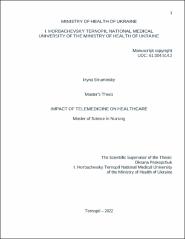IMPACT OF TELEMEDICINE ON HEALTHCARE
Короткий опис(реферат)
Telemedicine allows health care professionals to evaluate, diagnose and treat patients at a distance using telecommunications technology. The approach has been through a striking evolution in the last decade and it is becoming an increasingly important part of the American healthcare infrastructure. According to numerous authors, telemedicine areas of practice allow medical care to be provided remotely through video conferencing facilities. Following this trend, today, several medical services, including primary care consultations and psychotherapy services are provided using telemedicine. Based on this background, this study focuses on understanding the impact of telemedicine on healthcare using access, as an area of interest. The central thesis is that telemedicine use has had a positive impact on the health sector. The aim of this project is to investigate the impact of telemedicine on the healthcare sector, attention will be made to understand its impact on healthcare access. The research questions underpinning this investigation are focused on understanding how telemedicine affects different aspects of healthcare access, including the convenience of accessing care, cost of accessing care, geographical distribution of healthcare services, and improvements in service capacity building. The research study was conducted using the mixed methods research approach, which contains qualitative and quantitative aspects of investigation into the analysis. The central thesis underpinning this study was that telemedicine had a positive impact on healthcare. Convenience, cost, service capabilities, and geographical distribution of health services emerged as key variables explaining access to health services. Broadly, the findings of the investigation confirmed the thesis by demonstrating a positive impact of telemedicine on all four areas mentioned above. Nonetheless, the current investigation concerning the impact of telemedicine on healthcare is marred by institutional, economic, and attitudinal factors affecting implementation. Given that many countries grapple with limited access to healthcare services for a majority of the population, underserved populations, such as people with disabilities and minorities, could enjoy increased access to healthcare services by using telemedicine. Patients who are geographically isolated from a majority of the population, such as the elderly, military officers, and prisoners, are also likely to benefit from an increased access to healthcare services through telemedicine use, as described in this paper. In summary future research studies should focus on evaluating the effectiveness of telemedicine use using qualitative means of data collection. Researchers need to pay more attention to informant selection because there is insufficient evidence showing the use of larger control trials in investigating the impact of telemedicine in the health care sector. Given that internet access and resource limitations have been identified as some of the major impediments to the minimization of health inequalities through telemedicine, governments should increase internet access and technological literacy among populations to enhance their acceptance of telemedicine.

